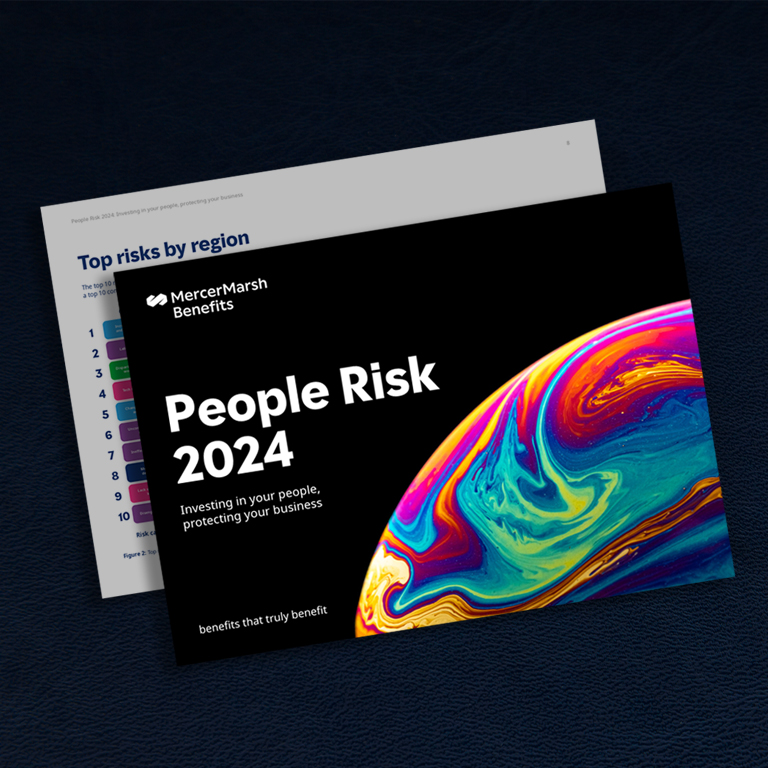
Many Wu
Principal, Global Health & Well-being, Mercer
-
United States
Despite this, governments continue to underinvest in mental health support. On average, countries spend just 2% of their healthcare budgets on mental health[1] — leaving those experiencing mental health conditions with limited access to treatment. At the same time, medical insurers often fail to provide essential and sufficient mental health outpatient coverage, such as counselling and therapy, further limiting the options for those in need of support. According to Mercer Marsh Benefits (MMB) Health Trends Report, only 47% of insurers globally typically include coverage for counselling sessions.
This is not only having an acute impact on individuals, but also on the organizations for which they work. MMB People Risk 2024[2][3] research found that mental health is the second most severe people risk faced by today’s HR and risk professionals —in many places, mental health deterioration leading to lowered productivity[4] along with increased absenteeism.[5] The result? Twelve billion working days lost each year to depression and anxiety, at a cost of US$1 trillion a year to global businesses.[6]
In the face of government underinvestment, limited insurance coverage and the evolving work environment, it’s time for employers to go beyond traditional notions of workplace safety and prioritize mental health support for employees. While physical risks have long been addressed through mandated guidelines and protective measures, it is equally important to recognize that work environments and factors like workload, work pace, civility and harassment impact an employee’s mental well-being. Governments and regulators are increasingly mandating organizations to do more to manage psychosocial risks in the workplace — with global regulations such as ISO 45003 requiring organizations to safeguard not just their workers’ physical safety but their mental health too. By utilizing risk assessment methodologies, organizations can identify and mitigate these psychosocial risks, establishing protective and supportive practices to do the right thing for their people and for their bottom line.
While developing a comprehensive mental health strategy takes time, there are ‘quick wins’ that employers can implement to make a meaningful impact and demonstrate to employees their commitment to protecting their mental well-being. These are:
It is important to remove any lingering stigma around mental health by openly talking about issues such as anxiety and depression in the workplace. Senior managers should lead by example, modelling positive mental health behaviors such as ensuring their own healthy work-life balance and creating a culture that prioritizes mental health. This might involve training line managers to recognize mental health challenges in their team members and direct them to existing resources like an employee assistance program.
There is a growing gap between the support and treatments that employees need and what they can access. Employers should use listening sessions and focus groups to understand the unique mental health challenges their workforce faces, leading to more tailored and effective initiatives.
It is important to ensure that every voice is heard, to ensure that your strategy is inclusive and addresses the needs of all employees. For example, people with caregiving responsibilities often report high levels of emotional stress[7] and are more likely to work when feeling mentally unwell, putting them at greater risk of burnout. Meanwhile, there is growing evidence that neurodiverse employees worry about stigma and discrimination from their colleagues and employers may need to make specific adjustments to support their mental well-being, such as providing flexible work schedules and private work spaces.[8]
Figure 1 | Source: MMB Health on Demand 2023
MMB Health Trends found that 43% of insurers globally typically cover inpatient mental health treatment and about half cover counselling/outpatient treatment. Opportunities remain to move the needle and drive additional insurers to include mental health coverage without any exclusions and waiting periods enabling employees to get the treatment they need, when they need it. Innovation in mental health takes time but employers play a crucial role in driving insurers to enhance their benefit offering or adopt new solutions such as teletherapy, mental health apps, and adolescent care and so forth. As you prepare for your upcoming medical insurance plan renewal review your policy and confirm if mental health is a covered benefit. Then, validate if there are any exclusions or limitations and negotiate with your insurer to remove them.
As we face the challenges regarding the future of work, prioritizing mental well-being is no longer nice-to-have, it’s essential. While governments and insurers must do more, employers have a vested interest in leading the charge. By openly addressing mental health, listening to employee needs and ensuring access to quality treatment, organizations not only improve productivity and retention but also build a stronger, more resilient organization.
[1] World Health Organization (2021). Mental Health ATLAS 2020.
[2] Mercer People Risk Management
[3] Marsh The five pillars of people risk
[4] Beck, Crain, Solberg, Unutzer, Glasglow, Maciosek, Whitebird. “Severity of Depression and Magnitude of Productivity Loss”, Ann Fam Med. Vol 9 Issue 4 (2011) pp.305–311
[5] Bryan, Bryce, Roberts. The effect of mental and physical health problems on sickness absence. Eur J Health Econ. Vol 22 Issue 9 (2021). pp.1519–1533
[6] World Health Organization Mental health at work. (2022).
[7] AARP (2023) A look at US caregivers’ mental health
[8] McDowell, A., Doyle, N. & Kiseleva, M. (2023). Neurodiversity at work: Demand, supply and a gap analysis. Birkbeck, University of London

Principal, Global Health & Well-being, Mercer
United States

Total Health Management Business Leader, Mercer Marsh Benefits
Canada

Report
04/23/2024